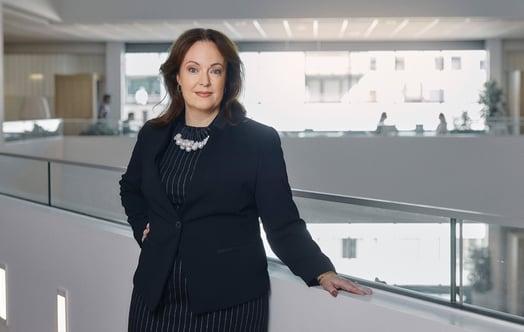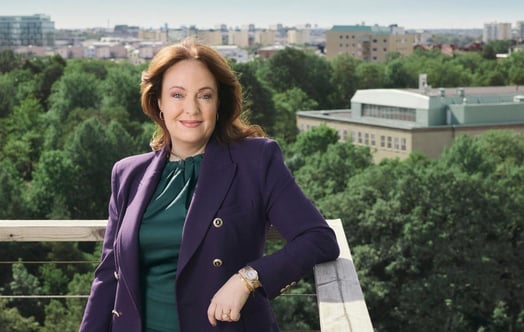Increased sales, record nuclear power generation and progress for Wind, but continued challenges for Heat. The price of electricity rose, but this did not have a material impact due to ongoing hedges. This is how 2018 can be summarised for Vattenfall.
Video player requires marketing cookies.
To view this content please click here to allow marketing cookies.
Vattenfall's 2018 profit increased by SEK 2.5 billion to SEK 12 billion. The increase is greatly due to corporate tax reductions in Sweden and re-evaluation of shares in the Nuclear Waste Fund to fair value. The Board of Directors proposes a dividend to the owner, the Swedish state, of SEK 2 billion.
The underlying operating profit for the year dropped, however, by SEK 3.3 billion to SEK 19.9 billion.
"It has been an interesting and challenging year. We have had good generation in our nuclear and hydro power operations but the high electricity prices have not had the corresponding impact on our numbers. This is because of the hedging we do to ensure price stability over time. Last year, they provided a good profit, but not this year. We also have a lower profit in our heat operations due to high fuel and CO2 prices. This was partially balanced by a profit increase in our Wind operations," says Magnus Hall, Vattenfall CEO and President.
Power Generation generated well
Electricity generation in the Nordics remained strong in 2018 and the nuclear operations set a generation record of 55 TWh. Hydro power generated 36 TWh, in the same level as 2017. But previous hedging entailed that the underlying operating profit for the Power Generation segment dropped by SEK 1.4 billion to SEK 9.4 billion.
Continued challenges for the heat business
For the heat operations, 2018 meant significantly raised costs for fuel and emission allowances, which contributed to a decrease in the underlying operating profit: SEK 0.8 billion as compared to SEK 3.4 billion the year before.
"A portion of this decrease is due to one-off effects in 2017 which had a positive effect on that year, but the big difference is that we have not been able to compensate for the increased costs. We now have a lot of work ahead of us to continue to enhance efficiency and to reduce exposure to emissions costs. In Berlin, for example, we have achieved our target of halving carbon dioxide emissions by 2020 already three years in advance, and in Uppsala we are investing SEK 3.5 billion in new plants," says Hall.
Onward for wind energy
Wind energy made vital progress in 2018 in which higher electricity prices and increased capacity led to an increase in profit by SEK 1.6 billion to SEK 3.7 billion. A decision was taken during the fourth quarter to invest in the Danish offshore wind farm Kriegers Flak with a capacity of 605 MW.
In 2018, Vattenfall invested SEK 8.2 billion in wind energy and other renewable generation, an increase of 46 per cent compared to the previous year. Another SEK 24 billion will be invested in 2019 and 2020 in new wind capacity, corresponding to 75 per cent of Vattenfall's total budget for growth investments.
Sales increased
Sales of electricity and gas increased on most markets and the customer base increased by 1.9 per cent to 8.9 billion contracts. The InCharge charging network is steadily growing and reached 10,500 charging points during the year. The underlying operating profit for Customers & Solutions decreased, however, by SEK 600 million to SEK 1.3 billion, greatly due to investments in growth.
Large investments in electricity grids
In Distribution, investments in the electricity grid increased by over 20 per cent in Sweden. However, new legislation will lead to that Vattenfall decreases its future investments.
"It is a cumbersome situation for us because we want to, and need to, invest in network upgrades, not only to enable the connection of all new renewable capacity, but also to construct the infrastructure that will be needed to meet growing urban needs. The new regulation of Sweden's electricity grid tariffs makes this difficult. For us, it means we need to lower our investment ambitions," says Anna Borg.
Just after the New Year, the storm Alfrida caused great damage in Sweden. At most, 63,000 of Vattenfall's customers were without power. Restoration work will continue for much of the year.
"A special thank you goes to all those involved in the great efforts to help our customers through a difficult situation," says Hall.
Vattenfall's electricity grid company in Berlin signed a contract during the year for charging infrastructure as the city undertakes to replace its 1,400 diesel buses with electrical buses.
The underlying operating profit for Distribution increased by SEK 200 million to SEK 6.3 billion in 2018.
The savings programme continues
To increase efficiency, Vattenfall is conducting a programme for saving SEK 2 billion by 2020 in staff and support functions. This project has progressed according to plan and by the end of the year, staff was reduced by 400 full-time equivalents.


